Learning Some of Turkey's Reputation is Deserved
I was nervous about visiting Turkey. Amidst the refuges crisis, seeing Europe
flooded with migrants using Turkey as a springboard to Greece I wasn’t sure
what to expect. The month before our trip,
Europe saw the largest number of migrants enter its borders through Turkey in a
single month ever. Things were getting
worse not better. Even cruise lines were
cancelling over night stays in the country, ensuring they left port before
sunset.
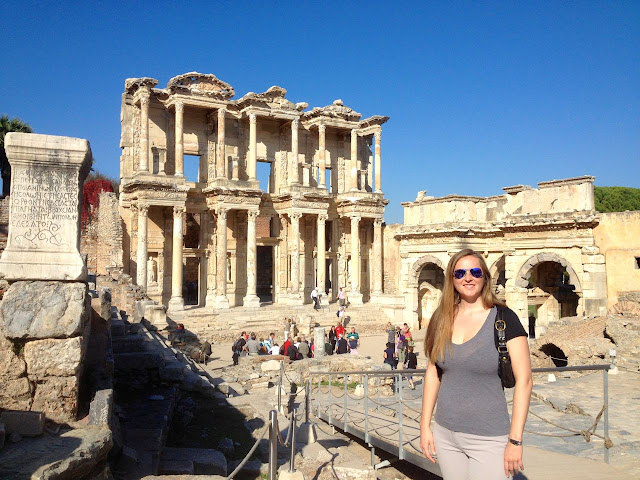 |
| The library and gates to the market at ancient Ephesus, one of the cities mentioned in the book of Revelations. |
My experiences in Israel and Jordan and the subsequent increase
in violence not only in these two countries, but also the Middle East in
general left me apprehensive about returning to the region until the violence
subsided. Never-the-less our cruise ship
was going to dock in Turkey and I was not traveling half way around the world
to pass up an opportunity to learn about the history and culture of another
country, especially one as unique a Turkey, not quite European not quite Middle
Eastern. Turkey even has its own
language further setting it apart from the two regions it serves as a bridge
between.
 |
| A nice new van for our fourteen person tour. |
We landed in Kusadasi a coastal city on the western
peninsula of Turkey. Despite being a
large enough town in and of its own right, most travelers use Kusadasi as an access
point to visit what remains of the ancient Greek colony of Ephesus. At three thousand years old, what remains of Ephesus lies
nine miles from Kusadasi.
 |
| Ephesus fell mostly to earthquakes. Much of the structures now standing have been reconstructed like this one. |
Once a port city, Ephesus is miles away from the ocean as
well. Centuries of earthquakes and natural
mountain-building raised the elevation of the city removing from its strategic
position on the sea. Earthquakes and
other natural disasters also reduced most of the ancient structures of the city
to piles of rubble, some of which has been reconstructed by the Turkish government.
 |
| An ancient representation of a serpent and staff indicates where the hospital once stood in Ephesus. |
Round trip taxi rates to Ephesus (including waiting time)
are set a standard rate of sixty euros per car.
We had planned to grab a taxi from the port, but jumped on a twenty euro
tour instead that we found in the port.
The tour was not overly large at fourteen people, and aside from being
cheaper than the taxi included a guide and some additional stops.
 |
| An upper street of Ephesus, where the poor residents lived. |
Ephesus as we learned on our tour, was home to a large
population and some important historical structures. The still standing Library of Ephesus was the
third largest in the ancient world, an impressive feat in the time before the
printing press when all books had to be copied by hand. The library also served as a convenient
excuse for men wanting to visit a brothel across the street as it had a secret
passageway connecting the two structures.
 |
| The main amphitheater of Ephesus where apostle Paul preached to thousands. |
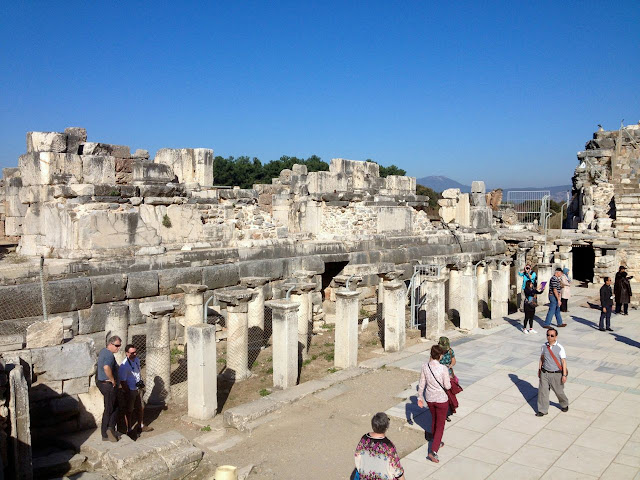 |
| Not much remains of the amphitheater stage background. |
The massive amphitheater which held twenty-five thousand
people was filled with the preaching of the Apostle Paul, and the remains of
several Greek Temples are reconstructed along the main road as well, showing
the presence of the dominant and newly budding religion of the age.
 |
| A panoramic view of the interior of the Ephesus library. It is not so large inside despite the grand facade. |
Ephesus might have been colonized by the Greeks, but the
Romans who conquered it one thousand years after its founding contributed as much to its
construction as the Greeks. One of the
largest structures still standing was a Roman hospital and pharmacy, identifiable
by the staff and serpent design which still symbolizes medicine today.
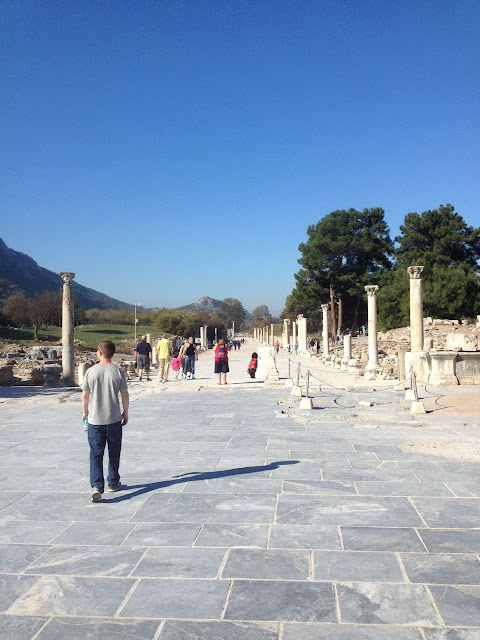 |
| David walks down the port of Ephesus where the ocean once lapped at its docks. Today the ocean is miles away due to tectonic uplift of the area. |
Aside from public buildings, remnants of homes still stand
along the main road. Called the terrace
houses, a set of two story row houses still retain intact their original mosaic
floors. These houses belonged to the
well-off of the city owing to their solid construction. The structures which the poor and middle
class lived in no longer stand.
 |
| All that remains of many of the temples at Ephesus are pulse of stone and statue. |
Our tour ended with a walk along the harbor road. Once lined with boats docked and unloading
goods, the ground is now level with or even higher than the road and covered in
grass. After exiting near the harbor
tourists must walk the gauntlet of a bazar to reach the safety of their tour
bus.
Turkey has a reputation for hawking fake goods. I thought we would see a few “prada” purses
or “rolex” watches. I was totally
unprepared for how unabashed the merchants were as they sold their knock off
merchandise, with advertisements promising “genuine fake watches.” As abundant as fake accessories I saw fake
spices. Many men walked up to tourists
trying pass off grass dyed orange as saffron.
The fake saffron looked so much not like the real thing I questioned if
the people making it actually knew what saffron looked like.
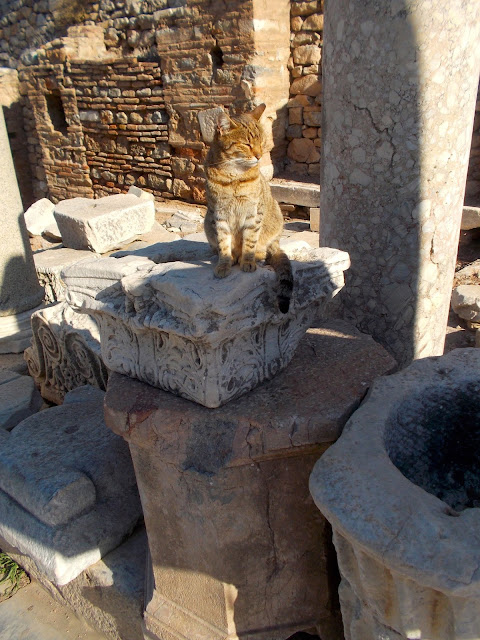 |
| A cat on a pedestal, I am sure right where it thinks it belongs. |
Of course our tour would not be complete without a couple of
shopping stops, although not listed in the tour description. At the first stop we were ushered into a
brightly lit room, with chairs encircling a cat walk. Little did we realize until models appeared
and music began blasting, we were about to see a fashion show. The fashion show featured only locally made
lamb-skin leather products, jackets mostly.
While I did like the styles I am trying not to buy animal products. Any temptation I felt about buying a jacket vanished
when I saw the prices, eight hundred US dollars, and that was half off. No one in our group bought anything. I don’t
think tourist choosing a budget tour are the right audience to buy thousand dollar
outerwear.
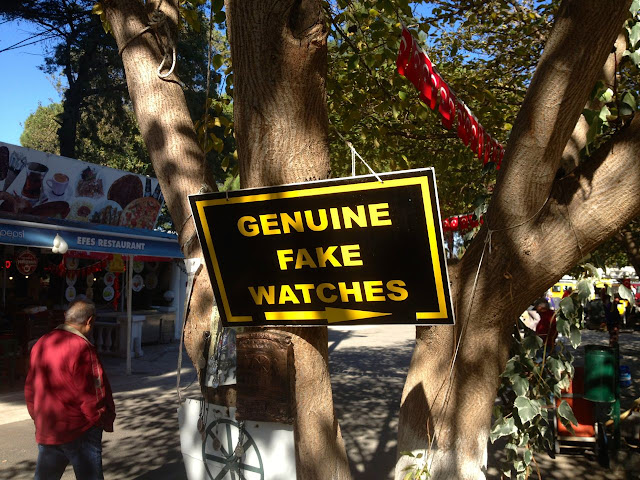 |
| This sign at the exit of Ephesus pretty much sums up Turkey for me. We saw everything from fake accessories to fake spices. |
The second shopping stop was more legitimate as a stop than
the leather goods store, it was a carpet weaving school funded by the Turkish
Government. At the school Turkish women
learn to spin wool, cotton, and silk in addition to learning how to make rugs with
that thread using a loom. Upon
graduation each woman receives a loom to take home and make a livelihood out
of. One of the school administrators
gave us a tour, including demonstrations of both silk spinning and weaving a
couple varieties of material.
 |
| We were surprised by this fashion show that popped up on our tour. |
I gained a whole new appreciation for hand made rugs watching
the women work. One square foot of silk
on silk rug requires three years to weave.
Learning this fact finally allowed me to understand one section of the Odyssey
by Homer I read in middle school. In the
Odyssey Odysseus is called off to fight in the Trojan War by Agamemnon. It takes him some twenty years to return
home. While Odysseus is away a neighbor
overtakes his house and tries to marry his wife Penelope. In ancient Greece one of the main duties of the
wife in a household was to weave all of the fabric needed by a family, and a
good weaver was seen as an attractive woman.
Penelope was an outstanding weaver, and she agrees to marry the intruder
under one condition, she must weave her wedding dress first. She never finished it. Part of the reason was that she partially undid
her work at the loom at night, but also the sheer amount of time required of
her to weave enough material for a wedding dress bought her enough time to wait
for Odysseus’s return and her liberation.
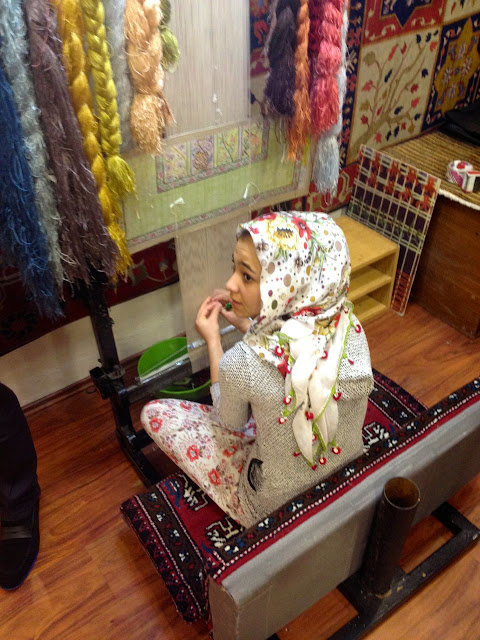 |
| This woman weaves a silk carpet at the carpet-making school we visited. It can take years to finish that tiny silk carpet. |
While everyone in our group seemed to appreciate the
demonstrations, just like a the leather shop no one purchased a rug. Hand made rugs are expensive since they
require so much time to make, and they are rather bulky to take home on a
plane.
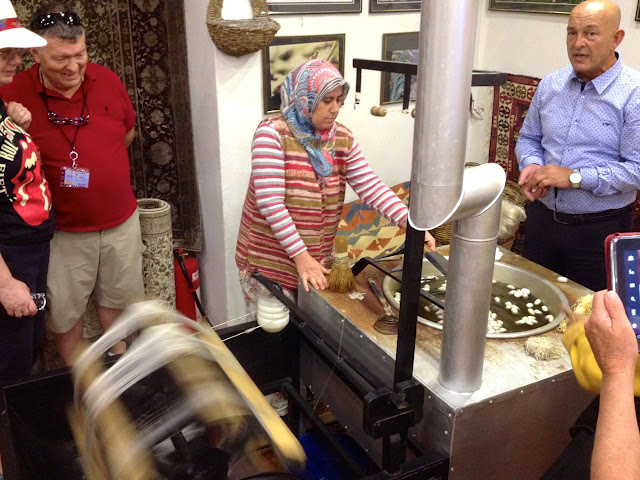 |
| This machine is used to spin silk from cocoons floating in the cauldron. |
Aside from the shopping stops we also made two stops at
other historical sites. We visited the
demure House of the Virgin Mary and Apostle John. Those who read the Bible often or have a good
memory may remember that on the cross Jesus instructs John and his mother to
take care of one another as adopted mother and son. After Jesus’s death they moved to this area
of Turkey, and the house they lived in still stands, with a shrine inside where
visitors can pray to the virgin. Outside
on the walls below the house others write requests of the virgin on scraps of
cloth and tie them into the stone.
 |
| The house of the Virgin Mary is now a shrine to her. She supposedly lived here with Apostle John after the death of Jesus. |
I am not of a faith which reveres the Virgin Mary any
special powers, but I did appreciate the stop.
The park surrounding the house was quiet and filled with trees fully
showing the colors of fall. I enjoyed just
listening to the wind shake the leaves of the trees.
 |
| Visitors to the house of the Virgin Mary tie notes of their wishes to nets cast below her house. |
Our last historical stop was to see the remnants of one of
the seven wonders of the ancient world, the Temple of Artemis. When fully constructed, the temple was
flanked by rows upon rows of columns, one hundred twenty-seven in all. All that remains standing amongst the rubble
is one solitary column. A turtle pond occupies
half of the clearing on which the temple once stood. The temple subcame to earthquakes and
looting, much of its stone being recycled as construction material for
houses. On a hill overlooking the ruins
resides the church of Apostle John, where the remains of the saint are
buried.
After returning to the port we walked around for a few
minutes before getting back aboard the ship.
Merchants were rather aggressive with trying to sell their fake watches
or getting us to sit down to a meal. I
just didn’t feel like dealing with it, especially since I went with a local
tour operator for our transportation for the day, not through the cruise ship.
Speaking of the cruise ship shore excursions, our decision
to go local on this excursion instead of booking through the ship saved us as
much money as we did in Athens. The tour
cost twenty euros per person, and entrance fees to Ephesus and the House of the
Virgin Mary were fourteen and ten euros respectively, bringing the total for
the day to forty-four euros each. The
most similar shore excursion to Ephesus (and also the cheapest for the port)
was sixty-five dollars a person. I
realize some folks like to book through the ship for excursions if they are
worried they will be pressed for time and possibly miss the ship’s departure,
but this is not a worry for a trip to Ephesus.
As I said earlier Ephesus is only nine miles from the port, and even
through we got off the ship over an hour after it had docked, we returned two
hours before it left again. There was
plenty of time to make using a locally-based tour operator relatively stress
free.
So despite my initial worries, our time in Turkey was free
of any issues related to the migrant crisis or violence in nearby
countries. The only inconveince we
experienced was onboard the ship when we had to fork over our passports for
inspection by the Greek authorities. That
being said, I won’t be back until the Middle East has reached a state of stability
and the hemorrhaging of migrants has stopped.


I'm trying to wrap my head around "genuine fake watches"... as opposed to fake fake watches? Lol.
ReplyDeleteAnyways, I'm glad you were able to have a good time with no issues despite the current, err, debacle over there in Europe. I'd be pretty nervous about venturing over there too, especially with what happened in Cologne.